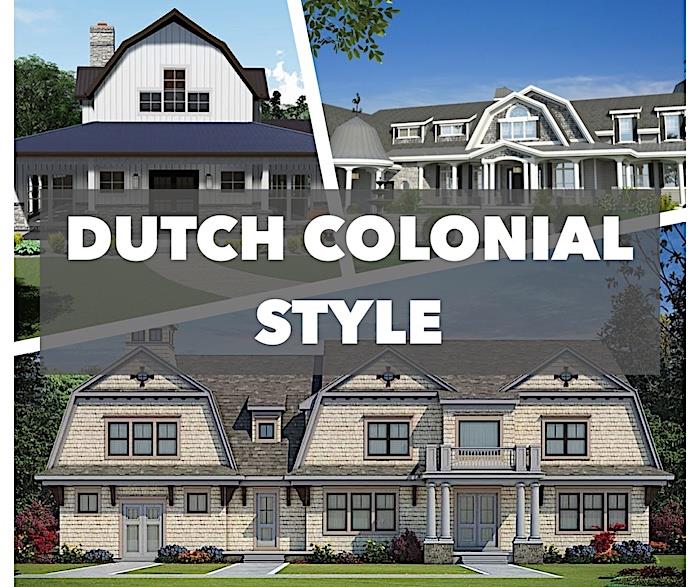Table Of Content

Dutch Colonial Revival architecture is distinguished by distinct features that have captivated the imaginations of homeowners and architects alike. Delving into these elements reveals a rich tapestry of design that echoes both artistic finesse and historical depth, setting the stage for an immersive exploration of its unique aesthetics. As Dutch Colonial Revival evolved, it began shaping other design trends.
1980s: Raised Ranch House Style
The house of Nicholas Schenck, Senior’s grandfather, Jan Martense Schenck, is also on display in the Museum. Together, these two houses suggest the way one Dutch American family might have lived in Brooklyn over a period of 150 years. Of course, many conjectural decisions were made, such as the precise locations of the exterior doors and the size and locations of the windows. On the interior, the location of the staircase to the loft and the form of the large open hearths and built-in bed box also involved conjecture, but were based on historical precedent. Its framework is composed of a dozen heavy so-called H-bents, visible on the interior of the house, that resemble goal posts with diagonal braces. This is an ancient northern European method of construction that contrasts with the boxlike house frames that evolved in England.
What are some more popular characteristics of individual colonial styles that set them apart from others?

The color palette was muted, using calm tones often paired with soft white walls. French Colonials are highly prevalent in the American Southeast, particularly Louisiana. They are known for their square, symmetrical styling, steeply pitched roofs, and expansive, wrap-around porches on both lower and upper levels. French-style double doors are used for the front door, which is centered on the house and usually flanked by two windows.
See How a Plain Dutch Colonial Became a Cool, Modern Farmhouse

Schifferstadt Architectural Museum in Frederick, Maryland is a landmark example of German Colonial Architecture. Named by Joseph Brunner after his childhood home near Mannheim, Germany, the house was completed in 1756. The Friends of Alice Austen House, Inc, begun in the 1960s and incorporated in 1979, continue to promote Clear Comfort and the accomplishments of Alice Austen. In agreement with the New York City Department of Parks and Recreation, they operate the house and garden as an historic house museum and continue the restoration. Clear Comfort, now a National Historic Landmark, was purchased in 1844 by Alice Austen’s grandfather, John Haggerty Austen, a well-to-do businessman, whose wife gave the house its name. Located at the entrance to New York Harbor, Clear Comfort stands today as a reminder of the picturesque suburban “cottages” that dotted the shore and hills of 19th-century Staten Island.
More in Design
The briefly popular Lustron Homes were essentially Ranch houses made of metal. Real estate developers Abraham Levitt and Sons turned to the Ranch Style for their planned community, Levittown, Pennsylvania. One-story Ranch Style homes are so simple, some critics say they have no style.
Dutch Colonial From Nightmare on Elm Street Sells for $2.98 Million - Architectural Digest
Dutch Colonial From Nightmare on Elm Street Sells for $2.98 Million.
Posted: Thu, 13 Jan 2022 08:00:00 GMT [source]
Contemporary Ranch Style homes are often accented with details borrowed from Mediterranean or Colonial styles. Pueblo Revival houses became popular in the early 1900s, mainly in California and the southwestern United States. During the 1920s, aviation pioneer Glenn Curtiss and his partner James Bright introduced their own version of Pueblo Revival architecture to Florida. In the region that is now Miami Springs, Curtiss and Bright built an entire development of thick-walled buildings made of wood frame or concrete block.
1860: Greek Revival House Style
Spanish colonial homes feature white stucco exteriors and red tile roofs. Although, since settlers built with surrounding materials, the exterior sometimes looked different. Sometimes the term Postmodern is loosely used to describe Neoeclectic and Neotraditional homes that combine a variety of historic styles. But unless there is a sense of surprise, irony, or originality, Neoeclectic and Neotraditional homes are not truly postmodern. Postmodern houses are also sometimes called "Contemporaries," but a true Contemporary Style house does not incorporate traditional or historical architectural details.
The historical Dutch colonial architecture has been around forever and will not disappear anytime soon. These classically beautiful houses not only evolve with the world around them, but become more modern and adaptable over the years. While the style lost its popularity for a few decades, the end of the XIX century brought a new popularity to this style of home. Houses built during this century and beyond are technically called “Dutch colonial revival” architecture, although colloquially the term “Dutch Colonial” is also acceptable.
Comparing Dutch Colonial with Other Colonial Styles
Whether it's a Colonial or Victorian look to a bit more Modern or Postmodern, or something in between, there's something for every taste. However, early Colonial style was very simple, straightforward, and rustic. Later furniture styles included cabriole chairs, claw-foot tables, and highboys. Other popular materials used during the period were rattan, wicker, reed, sisal, jute, and wool woven textures, including braided rugs on the floors.
In the early-to-mid-1900s, the style experienced a widespread revival. Dutch Colonial style homes began to pop up in more areas of the United States, and replicas continue to do so even today. We call these newer homes “Dutch Colonial Revival” style homes, as they were not built in the first wave. However, a true Country style house will tend to be a bit larger and have the more intricate and engaging wooden elements that you'd find in Dutch Colonial homes, like porch posts, siding, and trim. The Colonial style follows the architectural design styles of the first immigrants to the New World, i.e., northern and western Europe, primarily Great Britain (of course), France, The Netherlands, and Spain. Great Britain and The Netherlands especially influenced the original colonies of New England and the Mid-Atlantic.
When the Museum acquired the Nicholas Schenck House in 1929, the house was in a state of disrepair. When attempts to preserve it on site failed, the entire house was given to the Museum. Cape Cod Revivals cropped up from the 1920s to the 1950s, which helped popularize the style, spreading it all over New England and across the United States. Georgian architecture was prominent in the United States during the 1700 and 1800s.
What an incredible 1.03 acre property this equally beautiful wood-shingle colonial home sits. At the time, the property consisted of 100 acres which included two islands. In 1983 William and Mary Ann Dykes purchased the home and started restoring it to its 18th Century glory. Between the 1630s and the1680s, conflict and disease decimated the local Canarsie population, and after trading their land to the Dutch, only a few remained. The color of the woodwork is based on fragments of paint found under the fireplace mantel and accurately reproduces the original color. It is unlikely that the ceilings were painted white in the early nineteenth century.
A Massive Gilded Age Mansion in San Francisco Asks $32 Million - Mansion Global
A Massive Gilded Age Mansion in San Francisco Asks $32 Million.
Posted: Mon, 21 Aug 2023 07:00:00 GMT [source]
As the railroads expanded, factory-made building parts could be sent to far corners of the continent. What’s interesting about this particular home is how it retains the historic interior yet isn’t run down at all. Yes, there have been some updates over the years, but when you see the interior, you get the feeling that you’re living in an early 19th Century Colonial house. Below we showcase a series of different colonial houses, mostly the saltbox style which stems from the British colonial style.

No comments:
Post a Comment